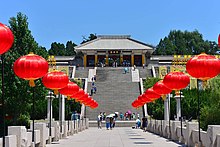Our website is made possible by displaying online advertisements to our visitors.
Please consider supporting us by disabling your ad blocker.
Chinese folk religion
| Chinese folk religion | |||||||||||||||||||||||
|---|---|---|---|---|---|---|---|---|---|---|---|---|---|---|---|---|---|---|---|---|---|---|---|
 Qing dynasty painting of the Chinese pantheon | |||||||||||||||||||||||
| Traditional Chinese | 中國民間信仰 | ||||||||||||||||||||||
| Simplified Chinese | 中国民间信仰 | ||||||||||||||||||||||
| |||||||||||||||||||||||
| Part of a series on |
| Chinese folk religion |
|---|
 |



Chinese folk religion comprises a range of traditional religious practices of Han Chinese, including the Chinese diaspora. This includes the veneration of shen ('spirits') and ancestors,[1] and worship devoted to deities and immortals, who can be deities of places or natural phenomena, of human behaviour, or progenitors of family lineages. Stories surrounding these gods form a loose canon of Chinese mythology. By the Song dynasty (960–1279), these practices had been blended with Buddhist, Confucian, and Taoist teachings to form the popular religious system which has lasted in many ways until the present day.[2] The government of China generally tolerates popular religious organizations, but has suppressed or persecuted those that they fear would undermine social stability.[3]
After the fall of the Qing dynasty in 1911, governments and modernizing elites condemned 'feudal superstition' and opposed traditional religious practices which they believed conflicted with modern values. By the late 20th century, these attitudes began to change in both mainland China and Taiwan, and many scholars now view folk religion in a positive light.[4] In China, the revival of traditional religion has benefited from official interest in preserving traditional culture, such as Mazuism and the Sanyi teaching in Fujian,[5] Yellow Emperor worship,[6] and other forms of local worship, such as that of the Dragon King, Pangu or Caishen.[7]
Feng shui, acupuncture, and traditional Chinese medicine reflect this world view, since features of the landscape as well as organs of the body are in correlation with the five powers and yin and yang.[8]
- ^ Teiser (1995), p. 378.
- ^ Overmyer (1986), p. 51.
- ^ Madsen, Richard (October 2010). "The Upsurge of Religion in China" (PDF). Journal of Democracy. 21 (4). Johns Hopkins University Press for the National Endowment for Democracy: 64–65. doi:10.1353/jod.2010.0013. S2CID 145160849. Archived from the original (PDF) on 1 November 2013. Retrieved 20 November 2010.
- ^ Gaenssbauer (2015), p. 28-37.
- ^ Zhuo, Xinping (2014). "Civil Society and the Multiple Existence of Religions". Relationship between Religion and State in the People's Republic of China (PDF). Vol. 4. pp. 22–23. Archived (PDF) from the original on 2 May 2014.
- ^ Sautman, 1997. pp. 80–81
- ^ Chau, Adam Yuet (2005). "The Politics of Legitimation and the Revival of Popular Religion in Shaanbei, North-Central China". Modern China. 31 (2). Sage: 236–278. doi:10.1177/0097700404274038. ISSN 0097-7004. JSTOR 20062608.
- ^ Overmyer (1986), p. 86.
Previous Page Next Page



